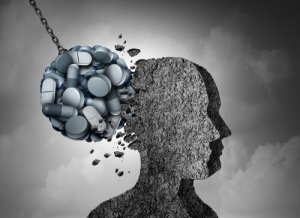Opioid Addiction and its Effects on the Brain

The serious health crisis in the United States due to the opioid addiction epidemic is putting the country and its institutions at risk. Unfortunately, there’s currently no feasible short-term solution for the problem.
The United States consumes 80 percent of the world’s production of opioids, either through prescriptions or illegally. As a result, health services are unable to cope with the number of deaths caused by opioid use.
Experts estimate that approximately 200 people die every day in the United States due to opioid addiction. Shockingly, the total number of deaths from this cause is already comparable to the deaths of American soldiers in the Vietnam War.
The data that’s now reaching us about the high incidence of addiction being generated by the consumption of opioids such as OxyContin or morphic derivatives such as Fentanyl have triggered many alarms. Statistics show that more than 10% of patients show strong signs of addiction after just five days of starting to use them.
Experts are calling this crisis “a national public health emergency” in the United States. In this article, we’ll be looking at what opioids are and their effects on the human brain. We’ll also look at the research that scientists are currently conducting.

What are opioids?
Opioids are pain-relieving drugs whose active ingredients come from the seed capsules of the opium plant. They’re natural substances that have long been known to be found in the juice (latex) of opium poppy seeds. In 1803, scientists successfully isolated an alkaloid from opium – morphine. Later, they developed derivatives such as codeine and heroin.
Opioids are strong analgesics doctors prescribe in cases of acute or chronic pain. Patients with cancer-related pain account for a significant percentage of them. The problem is that there are many risks surrounding their use. This mainly concerns the high rates of addiction they create in patients. We say patients because many of the people who get addicted are people who were prescribed opioids after surgery, an accident, or a broken arm.
Until 1914, opium was legal in the United States. It was later banned due to the high tolerance it creates and the severe withdrawal symptoms it produces. It’s one of the most addictive drugs, as it reaches the brain very quickly. It produces a powerful effect of analgesia, drowsiness, and gratifying sensations of pleasure.
There are three classes of opiate substances:
- Opium alkaloids, such as morphine (prototype opiate) and codeine.
- Semi-synthetic opioids, such as heroin and oxycodone.
- Fully synthetic opioids, such as pethidine and methadone.
What effects do they have on the brain?
These drugs activate the brain’s reward system. This system includes the ventral tegmental area, the nucleus accumbens, and the prefrontal cortex. Pain perception involves several neural structures.
Through afferent pathways, this substance reaches areas of the brainstem and diencephalon, including the thalamus and the periaqueductal gray. In addition, the thalamus produces synapses, which project to other areas, mainly the frontal lobe, the limbic system, and the hypothalamus.
Opioids act in the afferent nervous system (pathways by which the stimulus travels to the brain) but also in the efferent system (reverse pathways). They also activate the connections between the periaqueductal gray and the raphe nuclei. These successfully reduce pain by inhibiting the interneurons containing GABA.

What’s being done to tackle the crisis created by opioid addiction?
This opioid consumption crisis has opened up numerous fronts. On one hand, the people who have developed an addiction to these drugs are a drain on health services. Also, when they can’t obtain new prescriptions, they turn to the black market and replace them with heroin, which is cheaper and easier to obtain.
The work conducted by the research team at Mount Sinai Medical Center in Miami, Florida is particularly noteworthy. This research has focused on an intracellular network that controls the actions of opioids in the periaqueductal gray, as this network plays a very important role in the body’s analgesic response.
These researchers succeeded in blocking the RGSz1 gene, which is responsible for encoding the negative opioid tolerance modulator. The result was a significant reduction in pain with much lower doses of medication. In addition to this, taking the medication wasn’t as gratifying, which is one of the main reasons why people get addicted.
At the moment, the team is evaluating the opioids doctors are currently prescribing. They want to classify them by their addictive potential based on the RGS proteins they activate. Their findings may be decisive in the fight against this serious opioid use epidemic.
This text is provided for informational purposes only and does not replace consultation with a professional. If in doubt, consult your specialist.








